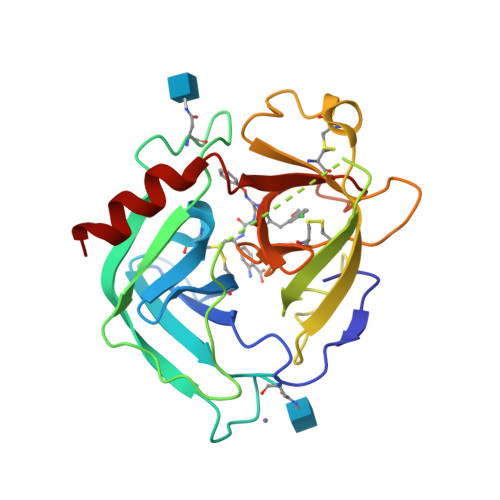
Top ▲

GtoPdb is requesting financial support from commercial users. Please see our sustainability page for more information.
Gene and Protein Information  |
||||||
| Species | TM | AA | Chromosomal Location | Gene Symbol | Gene Name | Reference |
| Human | - | 247 | 14q12 | CMA1 | chymase 1 | |
| Mouse | - | 247 | 14 28.19 cM | Cma1 | chymase 1, mast cell | |
| Rat | - | 247 | 15p13 | Cma1 | chymase 1 | |
Previous and Unofficial Names  |
| alpha-chymase | chymase 1, mast cell | mast cell protease 3 | mast cell protease 5 | mast cell protease I | mast cell protease III | MCP3P | Mcp5 |
Database Links  |
|
| Specialist databases | |
| MEROPS | S01.140 (Hs) |
| Other databases | |
| Alphafold | P23946 (Hs), P21844 (Mm), P50339 (Rn) |
| BRENDA | 3.4.21.39 |
| ChEMBL Target | CHEMBL4068 (Hs), CHEMBL3168 (Rn) |
| Ensembl Gene | ENSG00000092009 (Hs), ENSMUSG00000022225 (Mm), ENSRNOG00000020563 (Rn) |
| Entrez Gene | 1215 (Hs), 17228 (Mm), 25627 (Rn) |
| Human Protein Atlas | ENSG00000092009 (Hs) |
| KEGG Enzyme | 3.4.21.39 |
| KEGG Gene | hsa:1215 (Hs), mmu:17228 (Mm), rno:25627 (Rn) |
| OMIM | 118938 (Hs) |
| Pharos | P23946 (Hs) |
| RefSeq Nucleotide | NM_001836 (Hs), NM_010780 (Mm), NM_013092 (Rn) |
| RefSeq Protein | NP_001827 (Hs), NP_034910 (Mm), NP_037224 (Rn) |
| SynPHARM |
84824 (in complex with compound 7f [PMID: 29191554]) 78440 (in complex with JNJ-10311795) |
| UniProtKB | P23946 (Hs), P21844 (Mm), P50339 (Rn) |
| Wikipedia | CMA1 (Hs) |
Selected 3D Structures  |
|||||||||||||

|
|
||||||||||||
Enzyme Reaction  |
||||
|
||||
Download all structure-activity data for this target as a CSV file 
| Inhibitors | |||||||||||||||||||||||||||||||||||||||||||||||||||||||||||||||||||||||||||||||||||||||||||||||||||||||||||||||||||||||||||||||||||||||||||||||||||
| Key to terms and symbols | View all chemical structures | Click column headers to sort | |||||||||||||||||||||||||||||||||||||||||||||||||||||||||||||||||||||||||||||||||||||||||||||||||||||||||||||||||||||||||||||||||||||||||||||||||
|
|||||||||||||||||||||||||||||||||||||||||||||||||||||||||||||||||||||||||||||||||||||||||||||||||||||||||||||||||||||||||||||||||||||||||||||||||||
| Immunopharmacology Comments |
| Chymase is a chymotrypsin-like serine protease that is expressed by mast cells. Amongst its activities, chymase is involved in the conversion of angiotensin (AT) I to ATII, its protease activity cleaves latent TGFβ1 and IL-1β in the cellular environment to generate the active cytokines, and it can further stimulate mast cell degranulation in a self-amplification loop. The potential of chymase as a drug target for inflammatory and gastrointestinal disorders is reviewed by Heuston and Hyland (2012) [3]. Chymase inhibitors are being investigated for anti-inflammatory potential [4,7] (and cardiovascular disease [10]). |
| Cell Type Associations | ||||||||
|
| Immuno Process Associations | |||||||||
|
|||||||||
|
|||||||||
|
1. Futamura-Takahashi J, Tanaka T, Sugawara H, Iwashita S, Imajo S, Oyama Y, Muto T. (2018) Structure-based design, synthesis, and binding mode analysis of novel and potent chymase inhibitors. Bioorg Med Chem Lett, 28 (2): 188-192. [PMID:29191554]
2. Greco MN, Hawkins MJ, Powell ET, Almond Jr HR, de Garavilla L, Hall J, Minor LK, Wang Y, Corcoran TW, Di Cera E et al.. (2007) Discovery of potent, selective, orally active, nonpeptide inhibitors of human mast cell chymase. J Med Chem, 50 (8): 1727-30. [PMID:17361995]
3. Heuston S, Hyland NP. (2012) Chymase inhibition as a pharmacological target: a role in inflammatory and functional gastrointestinal disorders?. Br J Pharmacol, 167 (4): 732-40. [PMID:22646261]
4. Liu WX, Wang Y, Sang LX, Zhang S, Wang T, Zhou F, Gu SZ. (2016) Chymase inhibitor TY-51469 in therapy of inflammatory bowel disease. World J Gastroenterol, 22 (5): 1826-33. [PMID:26855541]
5. Palaniyandi SS, Nagai Y, Watanabe K, Ma M, Veeraveedu PT, Prakash P, Kamal FA, Abe Y, Yamaguchi K, Tachikawa H et al.. (2007) Chymase inhibition reduces the progression to heart failure after autoimmune myocarditis in rats. Exp Biol Med (Maywood), 232 (9): 1213-21. [PMID:17895529]
6. Schwartz LB, Austen KF. (1980) Enzymes of the mast cell granule. J Invest Dermatol, 74 (5): 349-53. [PMID:6771334]
7. Takato H, Yasui M, Ichikawa Y, Waseda Y, Inuzuka K, Nishizawa Y, Tagami A, Fujimura M, Nakao S. (2011) The specific chymase inhibitor TY-51469 suppresses the accumulation of neutrophils in the lung and reduces silica-induced pulmonary fibrosis in mice. Exp Lung Res, 37 (2): 101-8. [PMID:21128860]
8. Tsunemi K, Takai S, Nishimoto M, Jin D, Sakaguchi M, Muramatsu M, Yuda A, Sasaki S, Miyazaki M. (2004) A specific chymase inhibitor, 2-(5-formylamino-6-oxo-2-phenyl-1,6-dihydropyrimidine-1-yl)-N-[[3,4-dioxo-1-phenyl-7-(2-pyridyloxy)]-2-heptyl]acetamide (NK3201), suppresses development of abdominal aortic aneurysm in hamsters. J Pharmacol Exp Ther, 309 (3): 879-83. [PMID:14960660]
9. Welle M. (1997) Development, significance, and heterogeneity of mast cells with particular regard to the mast cell-specific proteases chymase and tryptase. J Leukoc Biol, 61 (3): 233-45. [PMID:9060446]
10. Yahiro E, Miura S, Imaizumi S, Uehara Y, Saku K. (2013) Chymase inhibitors. Curr Pharm Des, 19 (17): 3065-71. [PMID:23176221]
S1: Chymotrypsin: chymase 1. Last modified on 15/02/2018. Accessed on 06/07/2025. IUPHAR/BPS Guide to PHARMACOLOGY, https://www.guidetopharmacology.org/GRAC/ObjectDisplayForward?objectId=2340.